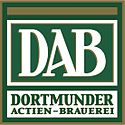Dortmund Actien Brewery
| Dortmunder Actien-Brauerei GmbH
|
|
|---|---|
| legal form | GmbH |
| founding | 1868 |
| Seat | Dortmund |
| management | Thomas Schneider, Uwe Helmich |
| Branch | Brewery |
| Website | www.dab.de |
| Status: 2020 | |
The Dortmunder Actien-Brauerei ( DAB ) is a Dortmund brewery on the north market .
history
The company was founded in 1868 by the Dortmund merchants Laurenz Fischer, Heinrich and Friedrich Mauritz together with master brewer Heinrich Herberz under the name of Bierbrauerei Herberz & Co. They bought the site in 1867 for 4,500 thalers . In 1872 the name was changed to Dortmunder Actien-Brauerei .
As one of the previously many breweries in the beer city of Dortmund, the brewery pursued an export strategy from 1879 . The DAB beer, produced from 1881 mainly as "Dortmunder Helles" in a bottom-fermented brewing method, was exported to all continents. In the same year, under the personal direction of Carl von Linde, one of the first refrigeration machines he invented is installed. In 1885, the annual production exceeded 100,000 hecto liters . In 1893, DAB was one of the first German breweries to set up a chemical-bacteriological laboratory .
In 1894 the founder Heinrich Mauritz died. From 1895 his son Theodor (1867–1944) took over the chairmanship of the supervisory board. At the turn of the century the brewery had an annual output of 160,000 hectoliters, in 1913 even 250,000 hectoliters.
When the concentration process after the First World War reduced the number of Dortmund breweries from 28 to 8, DAB was already on the expansion course and acquired the Tremonia brewery and the Meininghaus monastery brewery. By 1930 beer sales rose to 770,000 hectoliters. In 1933, Alfred Mauritz (1867–1938), son of Friedrich Mauritz and cousin of Theodor, became chairman of the supervisory board. During this time the beer output reached 800,000 hectoliters with a workforce of 750 people. After his death in 1938 Otto Mauritz , the son of Theodor Mauritz, took over the chairmanship of the supervisory board.
After the Second World War , the destroyed production facilities were rebuilt. In 1959, DAB was the second brewery in Germany to be the “hectolitre millionaire” and in 1968 it celebrated its 100th anniversary with an annual output of 1.6 million hectoliters.
In 1971, the Dortmunder Actien-Brauerei took over the majority of shares in its local competitor, Dortmunder Hansa, and on March 5, 1982, the company moved into the new building costing around 150 million marks on Steiger- / Burgholzstraße, the historic location of the former Borussia and later Hansa Brewery. The headquarters of the brewery remained on Rheinische Strasse, the traditional location, the so-called brewery district , until 1983 . The purchase price was generally considered too high. For several years, DAB was unable to recover from the financial burdens. In 1984 the new DAB is the largest brewery in the Ruhr area with an annual output of 2.6 million hectoliters.
The purchase of the trademark and distribution rights of the private brewery Dortmunder Kronen in 1996 could not stop the downward trend. In 1997 DAB expanded its brewing capacity from 3.4 million to 4 million hectoliters. In 2001 the supervisory board determined that the company was overindebted , and the Frankfurt Binding brewery initially secured its continued operation with loans.
In 2002, through the exclusion of minority shareholders by the Radeberger Group , which in turn belongs to the Oetker Group, the former shareholders were compensated.
On the premises of the DAB brewery on Steigerstraße, not far from Borsigplatz , the Dortmund Brewery Museum was reopened in April 2006 , which was previously housed in the Wenkerkeller of the private brewery Dortmunder Kronen. At the beginning of the 20th century, the Borussia brewery - namesake of the famous Dortmund football club - was located on this site and was later taken over by the Hansa brewery.
2006 the legal form was Dortmunder Actien Brauerei AG into a GmbH changed .
In February 2007 it was announced that the Dortmund beer would be advertised again. The bottle shape of the Dortmunder Kronen was changed, a new label was designed and the slogan “Die Krone Westfalens” became “From the heart of Dortmund”. Hövels is sold nationwide, DAB should grow more in Italy because it is already well received there, and Brinkhoff’s is also being advertised more.
See also
Web links
- Description of this sight on the route of industrial culture
- Historic beer coasters from the Dortmund Actien brewery (private site)
- Early documents and newspaper articles on the Dortmund Actien brewery in the 20th century press kit of the ZBW - Leibniz Information Center for Economics .
Individual evidence
- ^ Karl-Peter Ellerbrock: 150 Years of the Dortmund Actien Brewery . In: Metropole Ruhr , edition 01/2018, Regionalverband Ruhr (Ed.), Pp. 32–33
- ↑ Barbara Gerstein: Mauritz . In: Neue Deutsche Biographie 16 (1990), p. 445 (online version)
Coordinates: 51 ° 31 ′ 48 ″ N , 7 ° 28 ′ 3 ″ E






